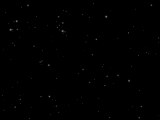
Note: This entire page is somewhat obsolete, since Metacreations has gone out of business, and Eovia now produces Carrara, the successor to Ray Dream Studio. Eovia has not released a plug-in SDK to the public, so I can't update my extension to work with it yet.
Use the starfield background extension in your deep space animations or stills. The extension creates a procedural starfield background and gives you maximum control over its appearance. Since the extension creates a background, the starfield extends over a full 360° and the algorithm used provides distortion-free stars even at the north and south 'poles' of the background sphere.
The current release for Ray Dream Studio is beta 2.4 and is free. It only works with the Windows version of RDS and does not expire. The current version is the last one for RDS. Note that RDS extensions do not work with Carrara.
I am working on a Carrara version of the extension (3.0). It will be released using the rolling expiration date, with a possibility that some future version of the extension will be shareware.
What's New in Version 2.4
User's guide
Example
FAQ
Download
Planned Improvements
Feedback
For Windows Programmers
Acknowledgements
To use the starfield extension, select the 'Effects' tab of the scene settings window. Under background, select 'Starfield' from the drop down list. Set the backdrop to 'Use Background'.
Base Color - The color of the background in areas where no stars are present.
Star Count - The total number of stars in the entire 360° background sphere. Unless you use one of the spherical cameras, only a fraction of this number will be visible in a specific render. Minimum 0, maximum 30 000. Because of a bug (I think in the RDS program), if you change the value of this field it will not affect the render until the value in one of the sliders or the color control is changed.
Size - The size of the brightest stars. A value of 1000 corresponds to the brightest stars having a radius of 1 degree. Minimum 1, maximum 1000.
Max Brightness - The brightness of the center point of the brightest star. 0 is black and 255 is white (or the brightest possible color). Setting the slider above 255 will result in an area larger than just the central point turning completely white. Minimum 0, maximum 512.
Min Brightness - The brightness of the center point of the dimmest star. Setting the slider above 255 will result in an area larger than just the central point turning completely white. If this value is greater than Max Brightness, the extension will automatically exchange the two in its internal calculations. Minimum 0, maximum 512.
Bright Falloff - There are more dim stars in the sky than bright ones. This control sets the strength of that effect (based on an exponential distribution). The value of the slider is the ratio of stars in the bottom 5% of brightness to the number of stars in the top 5% of brightness. Minimum 1.02, maximum 200.
Color Thresh - The human eye perceives dim objects (like most stars) in black and white. All points in star images that have a value less than the value of this slider (same scale as for brightness) will be pure gray scale. Points brighter than the slider setting will have an increasing color component. Minimum 0, maximum 256.
Seed - The number used as a seed for the pseudo-random number generator. Change it to 'shuffle' the starfield. Minimum 0, maximum 32 767. Because of a bug (I think in the RDS program), if you change the value of this field it will not affect the render until the value in one of the sliders or the color control is changed.
A render of the starfield background
using the default settings and a normal (50mm) camera.
Click on the image for a larger picture.
Will there be a Macintosh version? It does not seem likely at the moment. I have no access to either Macintoshes or Macintosh development tools.
Are you going to add nebulas? - This has been the most requested new feature. The major problem up to now has been the lack of a good user interface development tool for RDS extensions on Windows platforms. According to Metacreations, this problem will be solved in the software development kit (SDK) for their new product, Carrara, which is the successor to RDS (there will be no new version of RDS). Unfortunately, I continue to have problems with the interface development tool supplied with the Carrara SDK. If I can resolve these problems, I should be able to include nebulas in the next release (which will be for Carrara - see the Planned Improvements section).
starfield.zip (32 KB zip file)
Starfield extension copyright Evelio Perez-Albuerne,
1998-2000.
All rights reserved.
Contains the following files:
Unzip the archive and move the file starfield.rdx to the Ext folder of your Ray Dream directory (or one of its subfolders). Start RDS normally and it will automatically load the extension. This version (beta 2.4) only works with the Windows version of RDS and never expires. It does not work with Carrara.
Please read the FAQ first to see if your question is answered there. Please e-mail me with:
If you are interested in making your own extensions for RDS, you may find Eric Winemiller's page on using the Ray Dream SDK on Win32 systems useful. I have a page that covers using Borland C++ Builder for RDS extensions development.
Thanks to Eric Winemiller and to Metacreation's developer support (especially Christina Hall) for their help in answering my technical questions.
Back up to the Raydream page.
[Home] [Comp] [SF] [Med/Bio] [Other Sci] [Personal]